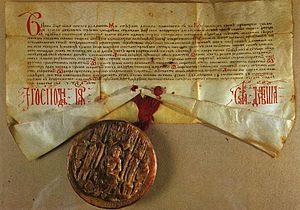
| Part of a series on the |
| Culture of Bosnia and Herzegovina |
|---|
 |
| People |
| Languages |
| Mythology |
| Cuisine |
| Festivals |
| Religion |
| Art |
| Literature |
| Music |
| Sport |

The literature of Bosnia and Herzegovina is a complex literary production within Bosnia and Herzegovina, which is seen as a unique, singular literature of Bosnia and Herzegovina (Bosnian and Herzegovinian literature, or Bosnian literature), consisting of literary traditions of the people of Bosnia and Herzegovina.
Depending on the period in history, it is written in Serbo-Croatian, Bosnian, Croatian, and Serbian languages, and uses both Latin and Cyrillic scripts, and historically, it used Ladino, Arabic, Persian and Ottoman-Turkish, with a use of peculiar form known as Aljamiado and Arebica. Hence, the literature of Bosnia and Herzegovina was realized within the framework of multicultural-civilizational paradigm. It is closely related to other South Slavic literature.
The most important representatives of modern literature are writers such as Ivo Andrić, Meša Selimović, Branko Ćopić, poets such as Mak Dizdar, Aleksa Šantić, Antun Branko Šimić, essayists such as Hamdija Kreševljaković, and present-day contemporaries such as poet Marko Vešović, playwright Abdulah Sidran, novelists Aleksandar Hemon, Miljenko Jergović, Saša Stanišić, and Andrej Nikolaidis, essayist Ivan Lovrenović, Željko Ivanković, Dubravko Lovrenović, Predrag Matvejević, and many others.
Going back to the medieval times, literature was predominantly ecclesiastical, with literacy revolving around a production of the Bosnian Church, and other religious liturgical, diplomatic and trade texts, based in Bosnian vernacular, an old form of Shtokavian dialect, Ijekavian dialect, in some cases Old Slavic, and using Bosančica (transl. Bosnian Cyrillic) and Glagolitic scripts. One specific peculiarity of this period in Bosnia and Herzegovina are written monuments in form of stećaks. The international trade agreement between Republic of Ragusa and the Bosnian medieval state of Ban Kulin, the Ban Kulin's charter, written in Bosnian vernacular using Bosančica, is the first such document among South Slavs, which appeared half a century earlier than first charter of any kind in Germany (the first one was from 1238/9), and just a little later than first such document in Christian Spain and southern France.
From late medieval and early modern times onward, the role of the Bosnian Franciscans became crucial for the literary developments, and their production in the same Bosnian vernacular Narodni jezik (transl. peoples language), written in Bosančica, became an integral part of the Bosnia and Herzegovina literature, with Matija Divković, the first Bosnian typographer who in 1611 printed the first Bosnian book, written in Bosnian using Bosančica, being dubbed the founding father of Bosnia and Herzegovina literature.